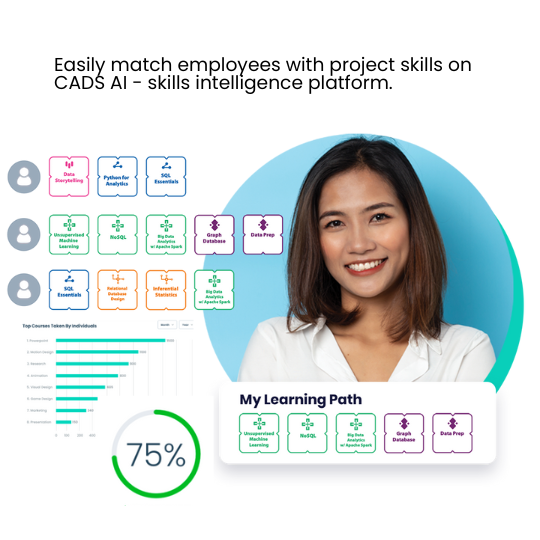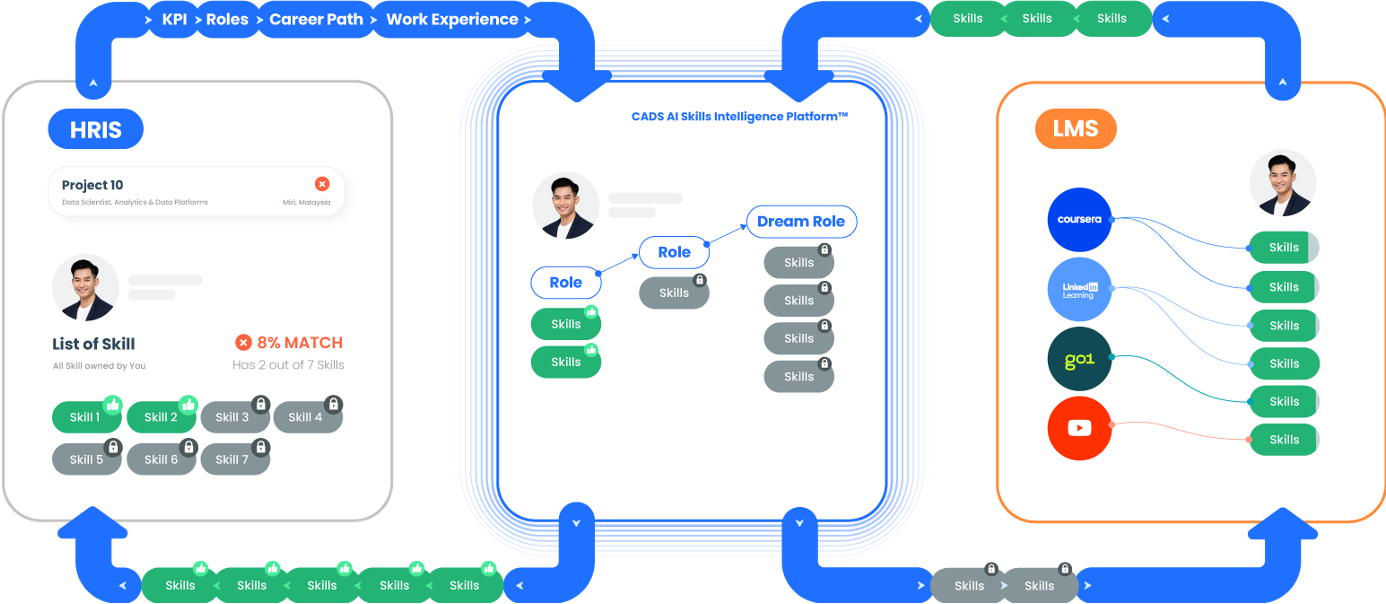How to use a Skills Intelligence Platform: A Guide for HR Leaders
In today's rapidly changing workplace, it is more important than ever for organizations to have a clear understanding of the skills and capabilities of their workforce. More and more, HR leaders find themselves at the forefront of impacting organizational success through talent management and development.
As data becomes more available, talent analytics play a bigger part to inform HR leaders of the growth potential or even health of their organization. Having a clear picture of what you have, goes a long way in seeing what you'll need to stay ahead in the future.
So how does a HR leader ensure business success through effective talent management? Well, here's a suggestion, use a skills driven approach. This approach lays the groundwork for a long term business goal alignment and is done through what we like to call "skills intelligence".
Skills Intelligence is a proactive, data-driven approach that uses real-time information on all manner of skills and its potential to help make talent decisions in an organization's plans, both current and future.
HR leaders can now find clear answers to questions like, “What skills do we need now, and in the future?” or “How do we map future skill needs to business objectives?” and allows clarity into workforce planning for flexible adjustments in the face of future disruptions.
➜ Let's explore how a skills intelligence platform can now enhance your talent analytics objectives.

➜ What is a Skills Intelligence Platform
A skills intelligence platform is basically a software solution that helps organizations identify, measure, and manage the skills of their employees. This information can then be used to make more informed decisions about hiring, training, and ongoing development.
Here are some of the benefits when using a skills intelligence platform to enhance your talent analytics.
1) Identify skills gaps in an organization
By understanding the skills that employees have, or the skills that they need, organizations can identify key areas of training and development or double their efforts if need be.
2) Match employees with the right jobs or specialties
Matching talent skills with the requirements of open positions ensures that placing or hiring the right people for the job is made better with data driven decision instead of a "wild guess" that someone can actually deliver on the tasks.
3) Develop tailored training programs
Developing crucial training programs that are specifically designed to meet individual needs is much-much better than a "batch" learning, as each talent would inherently have different levels of skill mastery and learning teams can then transfer these cost savings into other more critical budgets.
4) Track development progress
It is messy to track the progress of talent development, organizations have to ensure that they are getting the most out of their training and development programs, so a platform that do that and signal a growth would be much more valuable.
5) Make better decisions about talent acquisition & retention
By understanding the skills and capabilities of the workforce, organizations can make better decisions about who to hire, who to deploy on which projects, who to promote, and who to retain.

In short, skill intelligence platforms can help organizations to build a more skilled and agile workforce that is better equipped to meet the challenges of the future.
➜ What are the benefits of skill intelligence?
There are many benefits to using a skill intelligence platform. Some of the most important ones that we've experienced are:
1. Improved employee planning
Obviously, having a better understanding of the skills of employees, organizations can make better decisions about hiring, deployment, training, or even development.
2. Increased productivity
Everyone can agree that once we know, who fits better where in the organization, matching them at the right jobs or projects while providing the right training definitely improves employee productivity not to mention agility.
3. Reduced costs
By identifying skills gaps early on, leaders can prevent costly hiring mistakes or "mis-fits". They can also save money on training by providing employees with the training they need to develop to do the jobs rather than guessing if it helps.
4. Improved employee engagement
Providing employees with opportunities to develop their skills and advance their careers, organizations can improve employee engagement.
6. Enhanced competitive advantage
Businesses now gain a competitive advantage in the marketplace with having a skilled and agile workforce.

➜ How does it work?
Conceptually, these platforms typically use a combination of data sources to collect information about the skills of employees.
It starts with collecting skills data of the workforce, this could be done through in-built platform features or even farmed out to third party services.
Data collection is typically is done through various assessment methods and increasingly connected to the various HRIS systems in the market that companies are using. This however lacks the benchmarking and insight you're going for in that it is based on internal data and perhaps does not take into consideration current industry or global benchmarks.
1) Self-assessments
Where each employee completes an online self-assessments to claim their skills and capabilities.
2) Peer assessments
Where employees are asked to assess the skills of their peers based on a given parameter or set of predefined questions.
3) Third-party assessments
Third-party assessments used to validate the skills of employees from either a subject matter expert or a survey tool.
Once the relevant data has been collected, it is then analyzed to identify data points like skill levels, skills demands or shortages, topic gasps, or even psychographic data on types of employees in your team. This data is a great source of insight for you to evaluate the skill focus and align with what the business needs down range.
Having the insights could also benefit your future hiring plans, it's clear then who and what skills is needed for the jobs being posted. Btw, advanced skills platforms like CADS.AI has built in hiring and job fit features where you can find, assess and match external talents to find the right skills fit even before you open up those job boards, much like building your own talent pipeline, (even social media platform that is business and employment focus doesn't offer analytics assessments this way).
Once your skills data is in play and aligned to the business talent requirements, matching employees with the ideal jobs based on their skills levels or planning training becomes a simple workflow.
To round off the way Skills Intelligence Platforms work, it also tracks progress of individuals development over time to ensure the talent grows to meet your business goals.
Want to streamline your organization's skills assets?
CADS AI helps businesses prepare for the digital future
Learn More➜ What are the challenges of using a skill intelligence platform?
Here are some "challenges" that could impede your use of a skills platform:
- Data quality: The quality of the data that is collected by the platform is critical. If the data is not accurate, then the results of the analysis will be inaccurate.
- Organizational change: Implementing a skill intelligence platform can require significant organizational change. Employees may need to be trained on how to use the platform, and managers may need to be trained on how to interpret the results of the analysis.
- Cost: Skill intelligence platforms can be expensive to implement and maintain.
However CADS AI has found ways to overcome this challenges using it's dynamic AI engine and years of experience that our subject matter experts brings along.
➜ Conclusion
Skill intelligence platforms can be a valuable tool for HR leaders. By providing organizations with a better understanding of the skills of their workforce, skill intelligence platforms can help organizations make better decisions. This leads to improved productivity, reduced costs, and enhanced employee engagement.
If you are considering implementing a skill intelligence platform, there are a few things you should keep in mind:
First, you need to make sure that the platform is right for your organization and a platform who has years of domain assets and expertise.
Second, you need to be prepared for the challenges of implementation.
Finally, you need to be willing to invest in the platform for a good amount of time. Most leaders tend to use the evaluation to see the skills. It's wise to remember that good data is consistently collected, evaluated and practised. So implementing a skills driven approach in your organization is an investment and shouldn't be a try-out.
If you are willing to make the investment, then a skill intelligence platform can be an asset for your organization.
Are you ready to make a change, speak to us today and let’s chat over coffee, we get excited always to share about CADS AI skill intelligence platform and how it can work for you too.





